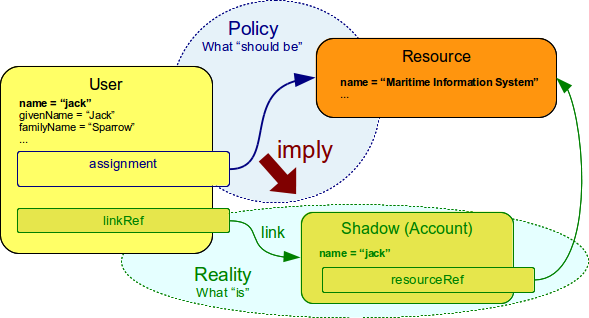
Assignment
|
Assignment feature
This page is an introduction to Assignment midPoint feature.
Please see the feature page for more details.
|
Assignment is a generic concept of associating user with the things that he should have or belong to. Assignment may associate user with an account, role, organizational unit or similar objects. Accounts and roles are the most common things that assignments are used for.
Assignment describes that the user should have something. It represents a decision or a policy, a desired state. The actual state of the user may be different. E.g. an account is assigned to a user, but such account cannot be created because the target resource is currently down. Assignment represents the desired state. The actual state of system as seen by midPoint is represented by links and shadow objects. It is a responsibility of IDM system to reconcile these two states and also real state of the target resource.

|
Why do we care so much about "policy vs reality"?
Because we are not naive. We just cannot pretend that everything is OK when it is not. Too often policy specifies one thing but the reality is very different. Provisioning system works with many information stores - its own repository and a lot of resources. While midPoint is usually set up to manage the resources system administrators can still use native administration tools to change things. Disabling such tools is usually not feasible and it is often also counter-productive. Other tools and events may also run parallel to midPoint. Therefore midPoint just must expect that things change "in the background". And if things change midPoint must know what really is there and what should be there. MidPoint must know the difference to be able to fix it. And to operate efficiently. And it does. |
Simple Role Assignment Example
Following diagram provides simple example of a user being assigned to a role.

The situation depicted in the diagram could be expressed in XML as:
<user oid="c0c010c0-d34d-b33f-f00d-111111111111">
<name>jack</name>
<fullName>Cpt. Jack Sparrow</fullName>
<givenName>Jack</givenName>
<familyName>Sparrow</familyName>
<honorificPrefix>Cpt.</honorificPrefix>
<assignment>
<targetRef oid="c0c010c0-d34d-b33f-f00d-444111111111" type="RoleType"/>
</assignment>
</user>
<role oid="c0c010c0-d34d-b33f-f00d-444111111111">
<name>Captain</name>
<!-- Complete role definition comes here -->
</role>Simple Account Assignment
We expect that most midPoint deployments will use roles to manage user accounts, entitlements and privileges. However we understand that there is always a need to make an "exception" or a special case. Therefore it is possible to assign account to a user directly.

In this case the assignment takes a slightly different form:
<user oid="c0c010c0-d34d-b33f-f00d-111111111111">
<name>jack</name>
<fullName>Cpt. Jack Sparrow</fullName>
<givenName>Jack</givenName>
<familyName>Sparrow</familyName>
<honorificPrefix>Cpt.</honorificPrefix>
<assignment>
<construction>
<resourceRef oid="c0c010c0-d34d-b33f-f00d-333345454545" type="ResourceType"/>
<kind>account</kind>
</construction>
</assignment>
</user>
<resource oid="c0c010c0-d34d-b33f-f00d-333345454545">
<name>Maritime Information System</name>
<!-- Complete resource definition comes here -->
</resource>The account is assigned directly to the user.
The construction structure is the same as the one used in role definitions therefore full power of expressions can be used to fine tune account attributes and entitlements.
Parametric Assignment
Assignment, all by itself, is a great and powerful mechanism.
But it can get even better.
One of the main purposes of the assignment structure is to contain parameters, e.g. parameters that are not related to the user or a role, but parameters that are related to the association of a user to a role.
The usual assignment parameters are start and end dates of the assignment.
This can be used in case a role is assigned to a user only for a specified amount of time, when a new employee record is created before he really joins the company, etc.
The assignment can also be temporarily disabled.
This kind of assignment parameters, called activation, is pre-defined in midPoint.
Therefore the IDM system will take care of processing that by itself, without any substantial customization.
Assignment parameters can be arbitrarily extended by using the extension element.
Such extension may contain any custom data and such data can be used in the expressions in assigned object.
Such assignment extensions can then be used as a parameters in the roles.
Therefore a role assignment can specify details such as a department for which the role applies, the branch office, access zone in the building and so on.
This parametric RBAC structure is a good mechanism to fight the role explosion problem.
See Advanced Hybrid RBAC for more details.
The Assignment Configuration page provides examples of such parametric assignments.
See Also
-
Assignment Configuration page in Documentation section
Compliance
This feature is related to the following compliance frameworks: